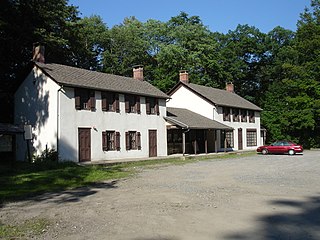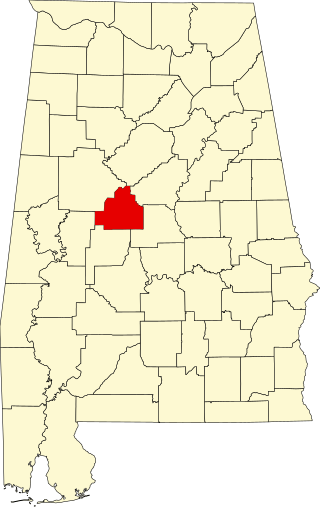
Centreville is a city in Bibb County, Alabama, United States. At the 2020 census, the population was 2,800. The city is the county seat of Bibb County.

Mooresville is a town in Limestone County, Alabama, United States, located southeast of the intersection of Interstate 565 and Interstate 65, and north of Wheeler Lake.

Ringwood Manor, located in Passaic County, New Jersey, was the site of an ironworks and home to a number of well-known ironmasters from the 1740s to the late 19th century. The current manor house was not built until 1807.

Long Pond Ironworks State Park is located in the community of Hewitt, in West Milford, New Jersey, United States. The park is known for its old stone walls, furnaces and other remnants of a once industrious ironworking community that now sits next to the swiftly flowing Wanaque River. The park is operated and maintained by the New Jersey Division of Parks and Forestry and has an area of 145 acres (0.59 km2).

The Tannehill Ironworks is the central feature of Tannehill Ironworks Historical State Park near the unincorporated town of McCalla in Tuscaloosa County, Alabama. Listed on the National Register of Historic Places as Tannehill Furnace, it was a major supplier of iron for Confederate ordnance. Remains of the old furnaces are located 12 miles (19 km) south of Bessemer off Interstate 59/Interstate 20 near the southern end of the Appalachian Mountains. The 2,063-acre (835 ha) park includes: the John Wesley Hall Grist Mill; the May Plantation Cotton Gin House; and the Iron & Steel Museum of Alabama.

Cornwall Furnace is located near Cedar Bluff, Alabama in Cherokee County. It was built by the Noble Brothers to supply iron products to the Confederate States of America during the American Civil War.

Cowpens Furnace Site (38CK73) is the remains of an early 19th-century iron-making furnace in Cherokee County, South Carolina. The site shows early American iron-making technology. The site was listed on the National Register of Historic Places in 1987.

Montebrier is a historic plantation house in Brierfield, Alabama. The 1+1⁄2-story frame structure was built circa 1853 by S.W. Mahan in a Gothic Revival cottage orné style. The house is notable for its use of lightly arched porch supports and wide eaves that may show the influence of Andrew Jackson Downing's The Architecture of Country Houses. It currently remains in the Mahan family as a private residence and was added to the National Register of Historic Places on April 2, 1973.

The Brierfield Furnace, also known as the Bibb Naval Furnace and Brierfield Ironworks, is a historic district in Brierfield, Alabama, encompassed by Brierfield Ironworks Historical State Park. The district covers 486 acres (197 ha) and includes one building and nine sites. It was listed on the National Register of Historic Places on November 20, 1974.

The Clinton Furnace, also known as the Clinton Ironworks, is located along Clinton Road at the base of the Clinton Reservoir by the Clinton Brook in the township of West Milford in Passaic County, New Jersey, United States. The furnace was built in 1826 and was added to the National Register of Historic Places on June 18, 1976, for its significance in industry. The furnace is the last surviving structure of the iron community once known as Clinton.

The Sloss Mines are a group of mines in southwestern Jefferson County, Alabama, United States. They were established by the Sloss Iron and Steel Company and its successor, the Sloss-Sheffield Iron and Steel Company, on the southern end of Red Mountain. The Sloss Iron and Steel Company itself was founded by James Sloss in 1881 as the Sloss Furnace Company. The Sloss Mines produced iron ore from 1882 until the 1960s. The ore that these mines produced were essential to the production of iron at the Sloss Furnaces, making them an important element in the formation of adjacent Birmingham and Bessemer as cities.

The Southfield Furnace Ruin in Southfields, New York, was a longtime smelting site for iron ore mined from nearby veins in what is now Sterling Forest State Park. It is located on the north side of Orange County Route 19, 0.7 miles northwest of the junction with New York State Route 17.

This is a list of the National Register of Historic Places listings in Bibb County, Alabama.

Washington Iron Furnace is an historic iron furnace, located in Rocky Mount, Franklin County, Virginia. The granite furnace was built around 1770, and measures 30 feet high on its south face. It helped establish industry in the county, and was listed on the National Register of Historic Places in 1973.

Bibb County Courthouse is a historic county courthouse in Centreville, Alabama, county seat of Bibb County, Alabama. It was built in 1902.

The Shelby Iron Company was an iron manufacturing company that operated an ironworks in Shelby, Alabama. The iron company produced iron for the Confederate States of America and was destroyed towards the end of the American Civil War. The company continued to produce iron until the early part of the 20th century.
Coopersville Ironworks Site (38CK2) and Susan Furnace Site (38CK67), also known as the Cherokee Ford Ironworks Site and Nesbitt Iron Manufacturing Co., is a historic archaeological site located near Gaffney, Cherokee County, South Carolina. The site includes the foundations of four large factory buildings, with a system of canal/sluiceways between them, and the remains of three iron furnaces. The outlying furnace, Susan Furnace, includes foundations, sluiceways, slag heaps, and adjacent ore pits. The complex is the largest and best preserved factory complex of any of the 19th century iron manufacturing companies of the region. The complex was developed between 1835 and 1843 by the Nesbitt Iron Manufacturing Company, the largest iron company in South Carolina. The Nesbitt Company was dissolved in the late 1840s, and the Swedish Iron Manufacturing Company of South Carolina operated the ironworks from 1850 until the American Civil War.
Ellen Furnace Site (38CK68) is a historic archaeological site located near Gaffney, Cherokee County, South Carolina. The site includes a partially collapsed but well-preserved iron furnace constructed about 1838 of quarried stone and two earthen sluiceways. Also present are building foundations, tramway road beds, and ore mines. It is directly associated with the nearby Susan Furnace Site. Both were outlying furnace operations associated with the manufacturing complex at Coopersville owned by the Nesbitt Company and later the Swedish Ironworks. The Coopersville Ironworks along with the Susan and Ellen Furnaces were developed between 1835 and 1843 by the Nesbitt Iron Manufacturing Company, the largest iron company in South Carolina. The Nesbitt Company was dissolved in the late 1840s, and the Swedish Iron Manufacturing Company of South Carolina operated the ironworks from 1850 until the American Civil War.

Eli Henderson Park at Janney Furnace is a park surrounding a fifty-foot tall stone furnace in Ohatchee, Alabama. The furnace was built in 1863 by Alfred Janney to produce pig iron due to the prevalence of iron ore in what is now the park. A July 1864 Union raid destroyed all but the stone chimney, which still remains. The furnace is now surrounded by the Calhoun County Confederate Memorial, built by Sons of Confederate Veterans in June 2003; and the 2009 Confederate and Native American Museum, which includes Civil War and Native American artifacts dating back to the Iron Age. The Confederate Memorial is the world's largest black granite confederate memorial. The furnace was listed on the National Register of Historic Places in 1976 and the surrounding park was re-named in honor of Eli Henderson in 2020, who sought to preserve it.

The Alabama Black Belt National Heritage Area is a National Heritage Area encompassing Bibb, Bullock, Butler, Choctaw, Clarke, Conecuh, Dallas, Greene, Hale, Lowndes, Macon, Marengo, Monroe, Montgomery, Perry, Pickens, Sumter, Washington, and Wilcox counties in the Black Belt region of Alabama. The Center for the Study of the Black Belt at the University of West Alabama serves as the local coordinating authority.




















